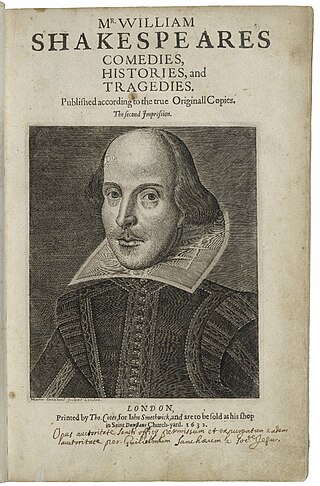Related Research Articles

The earliest texts of William Shakespeare's works were published during the 16th and 17th centuries in quarto or folio format. Folios are large, tall volumes; quartos are smaller, roughly half the size. The publications of the latter are usually abbreviated to Q1, Q2, etc., where the letter stands for "quarto" and the number for the first, second, or third edition published.
Humphrey Moseley was a prominent London publisher and bookseller in the middle seventeenth century.

John Benson was a London publisher of the middle seventeenth century, best remembered for a historically important publication of the Sonnets and miscellaneous poems of William Shakespeare in 1640.
William Jaggard was an Elizabethan and Jacobean printer and publisher, best known for his connection with the texts of William Shakespeare, most notably the First Folio of Shakespeare's plays. Jaggard's shop was "at the sign of the Half-Eagle and Key in Barbican."

The Second Folio is the 1632 edition of the collected plays of William Shakespeare. It follows the First Folio of 1623. Much language was updated in the Second Folio and there are almost 1,700 changes.

Ben Jonson collected his plays and other writings into a book he titled The Workes of Benjamin Jonson. In 1616 it was printed in London in the form of a folio. Second and third editions of his works were published posthumously in 1640 and 1692.
Thomas Creede was a printer of the Elizabethan and Jacobean eras, rated as "one of the best of his time." Based in London, he conducted his business under the sign of the Catherine Wheel in Thames Street from 1593 to 1600, and under the sign of the Eagle and Child in the Old Exchange from 1600 to 1617. Creede is best known for printing editions of works in English Renaissance drama, especially for ten editions of six Shakespearean plays and three works in the Shakespeare Apocrypha.
Robert Allot was a London bookseller and publisher of the early Caroline era; his shop was at the sign of the black bear in St. Paul's Churchyard. Though he was in business for a relatively short time – the decade from 1625 to 1635 – Allot had significant connections with the dramatic canons of the two greatest figures of English Renaissance theatre, William Shakespeare and Ben Jonson.

Philip Chetwinde was a seventeenth-century London bookseller and publisher, noted for his publication of the Third Folio of Shakespeare's plays.
John Smethwick was a London publisher of the Elizabethan, Jacobean, and Caroline eras. Along with colleague William Aspley, Smethwick was one of the "junior partners" in the publishing syndicate that issued the First Folio collection of Shakespeare's plays in 1623. As his title pages specify, his shop was "in St. Dunstan's Churchyard in Fleet Street, under the Dial."
Richard Meighen was a London publisher of the Jacobean and Caroline eras. He is noted for his publications of plays of English Renaissance drama; he published the second Ben Jonson folio of 1640/41, and was a member of the syndicate that issued the Second Folio of Shakespeare's collected plays in 1632.
Andrew Crooke and William Cooke were London publishers of the mid-17th-century. In partnership and individually, they issued significant texts of English Renaissance drama, most notably of the plays of James Shirley.
Nicholas Okes was an English printer in London of the Jacobean and Caroline eras, remembered for printing works of English Renaissance drama. He was responsible for early editions of works by many of the playwrights of the period, including William Shakespeare, Ben Jonson, John Webster, Thomas Middleton, Thomas Dekker, Thomas Heywood, James Shirley, and John Ford.
John Waterson was a London publisher and bookseller of the Jacobean and Caroline eras; he published significant works in English Renaissance drama, including plays by William Shakespeare, John Fletcher, John Webster, and Philip Massinger.
Humphrey Robinson was a prominent London publisher and bookseller of the middle seventeenth century.
Francis Constable was a London bookseller and publisher of the Jacobean and Caroline eras, noted for publishing a number of stage plays of English Renaissance drama.
Thomas Walkley was a London publisher and bookseller in the early and middle seventeenth century. He is noted for publishing a range of significant texts in English Renaissance drama, "and much other interesting literature."
William Leake, father and son, were London publishers and booksellers of the late sixteenth and the seventeenth centuries. They were responsible for a range of texts in English Renaissance drama and poetry, including works by Shakespeare and Beaumont and Fletcher.

Thomas Heyes was the publisher-bookseller who published the first quarto edition of William Shakespeare’s Merchant of Venice, in London, in 1600. He traded from 'St Paul’s Churchyard at the sign of the Green Dragon’.
William Bladen (1585–1663) was a bookseller and printer in London and Dublin in the 17th century. He served as Sheriff, Alderman and Mayor (1647–1648) of Dublin and was present in Dublin during the Irish Rebellion in 1641–1642.
References
- ↑ Henry Robert Plomer, A Dictionary of the Booksellers and Printers Who Were at Work in England, Scotland and Ireland from 1641 to 1667, London, The Bibliographical Society/Blades, East & Blades, 1907; p. 53.
- ↑ Henry Robert Plomer, A Short History of English Printing, 1476–1898, London, Kegan Paul, 1900; pp. 178–9.
- ↑ George Watson Cole and Philip Sanford Goulding, Check-List or Brief Catalogue of the Library of Henry E. Huntington, New York (privately printed), 1919.
- ↑ Peter Hampson Ditchfield, The Parish Clerk, London, Methuen, 1907; pp. 115–26.